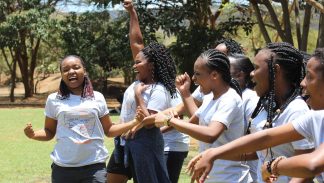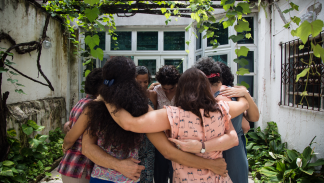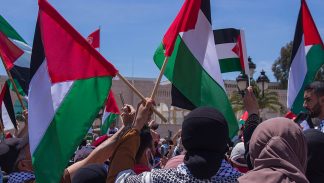One year later: Women rebuilding Nepal
On April 25, 2015, a 7.8-magnitude earthquake hit Nepal, leveling entire villages and bringing destruction and devastation. Less than three weeks later, another 7.3-magnitude quake shook the country. The aftershocks brought landslides and new dangers, impeding survivors’ efforts to find loved ones, seek shelter, and rebuild.
“A lot was lost in the dreadful event—more than 8,600 people lost their lives, one million people have been displaced, and many treasures of the country have been lost,” says Lily Thapa, reflecting one year later. “During the tragic moments, women suffered the most. They became immediate prey—subject to mental and physical harassment, sexual abuse, health degradation, and human trafficking.” Thapa also says that because women often put their many family members before themselves in a crisis, they often become the most vulnerable to diseases and other health hazards.
In the days and weeks that followed, it became clear that eight million people—more than a quarter of the country’s population—had been affected. Amid the destruction, grassroots women’s groups mobilized to fill gaps in immediate relief, and to assess and meet the unique needs of women and children—who are disproportionately impacted in disasters—and marginalized communities in the most remote areas.
In the aftermath of the quakes, Global Fund for Women’s international community came together quickly to raise more than $700,000 to support these fearless women. The money raised by thousands of donors around the world has supported both their immediate relief efforts, as well as their leadership in longer-term recovery and rehabilitation.
Filling gaps in immediate relief and recovery
“During the initial 70 days of intense relief operations Tewa and Nagarik Aawaz reached 112 communities in 15 affected districts and partnered with some 25 other organizations,” explains Sadhana Shrestha, Executive Director of Nepal’s only women’s fund, Tewa, which is collaborating with women’s group Nagarik Aawaz on all earthquake relief and recovery efforts. “In doing this some 23,000 households were reached and some 7,000 postnatal and pregnant women, elderly people, and children were supported directly.”
The approach taken by grassroots women’s groups immediately following the earthquake— speaking with women directly about their needs and the needs within their communities, while distributing temporary shelter, toiletries, and other necessities—is unique and helped them to make a larger impact in both the short- and long-term.
“After the earthquake, wherever we went to distribute goods and cash, we sat in circles with the community and talked to them of the impending brunt of the earthquake on women and children, and how vigilant women needed to be in camps,” says Shrestha.
Global Fund for Women’s grantee partners set up tents, tarps, and temporary shelters for women and their families that had lost their homes. Women Awareness Center Nepal, a long-time Global Fund for Women grantee partner that works with over 35,000 women in Nepal, distributed zinc corrugated tin sheets to women in the Kavre district to help them rebuild their homes.
Women’s groups also worked to meet women’s unique needs, distributing sanitary napkins, providing access to maternal and new baby health care and medicine, and providing dignity kits that included soap, mosquito nets, gowns, undergarments, and nutritious food. They also educated women and girls on the heightened risk for sexual violence and trafficking that occurs after natural disasters, giving them advice and knowledge to help them protect themselves. They reached pregnant women, and recent and nursing mothers to support their specific needs.
“Our main agenda in the recovery phase was to provide awareness and psychosocial counseling,” explains Lily Thapa, the founder of Global Fund for Women grantee partner Women for Human Rights. She explains that in Gorkha, near the epicenter of the storm, her organization created a common area with tents for displaced families to stay, adding, “There were many complaints about harassment that occurred while women were staying in the tents, so our awareness program was focused on educating people about gender-based violence.”
Reaching the most marginalized populations
Because these women’s groups have been working in communities in Nepal for years, even decades, they have been able to reach some of the most marginalized groups of women with their relief and recovery work, and focus on addressing their unique needs for the long-term.
Lily Thapa shared the story of Binda to highlight the specific needs elderly women can face: “Binda Koirala, an elderly woman from Kolgata, came to Women for Human Rights as no other organizations were working for elderly people. Our staff explained the importance of legal documentation for citizenship to Binda, who had never heard about it before. The staff then helped her to obtain a citizenship card, from which she now earns a monthly allowance as an elderly citizen.”
As our grantee partners explain, the most marginalized populations in Nepal continue to face increased discrimination, fewer job opportunities, and less support from families after the earthquake. Himalayan Grassroots Women’s Natural Resources Management Association is focusing on Dalit (“untouchable”) women for its rainwater harvesting and biogas tank project, set up with funding from Global Fund for Women, to address the fact that water has become even more scarce and women and girls’ safety is at risk traveling further to find clean water. Samrakshak Samuha Nepal (SASANE) and Shakti Samuha have each been focused on working with survivors of trafficking and those women and girls most at risk of trafficking, while Mitini Nepal focuses on lesbian, bisexual, and transgender women, and Srijansil Mahila Samuha works with women living with HIV and AIDS. Nepal Disabled Women’s Association is focused on women and girls with disabilities and helping mothers with children with disabilities.
Improving livelihoods, and empowering women survivors with economic opportunities
“After the earthquake, the women not only lost their homes, but they lost their incomes as many ran small businesses from their homes,” said Bandana Rana, founder of Saathi, a women’s group that set up the first-ever women’s shelter in Nepal twenty years ago with funding from Global Fund for Women.
One of the most critical parts of the rebuilding and long-term recovery process, according to our grantee partners, is empowering women with economic opportunities to ensure sustainable livelihoods. Many women’s groups in Nepal had already been focused for years on economic empowerment, providing women with skills and literacy trainings, lining up job opportunities, and teaching women about income generation and entrepreneurship. Since the earthquake, these efforts face new challenges. With homes, agricultural land and animals lost or destroyed women have fewer assets and a heightened need for income. Women who previously worked from homes that were destroyed in the quake now need access to co-op buildings to sustain their work.
“We’re promoting vocational training as it has been found to be the most effective way for the survivors to make an income, have food security, and a more sustainable livelihood,” explains Renu Rabjhandari, Global Fund for Women advisor and the founder and chairperson of Women’s Rehabilitation Centre (WOREC), which has been working on women’s rights in Nepal since 1991. “We provide trainings in tailoring, driving, plumbing, making woolen clothes, and handicrafts, along with leadership training so that women know how to negotiate with a market and can negotiate prices.”
Beyond Beijing Committee holds regular trainings for women with a local tailor to teach them how to make their own sanitary pads, either for their own use or for selling to local markets, explains Ruby Shakya, Program Manager of the Global Fund for Women grantee partner.
What’s next for women-led recovery in Nepal
One year after the earthquake, many women and families are still living in temporary shelters, and Global Fund for Women’s grantee partners are working on addressing critical women’s needs for the long-term, including economic and leadership opportunities, psychosocial counseling, ending gender-based violence, and access to health care and reproductive rights.
“Slowly, communities have started to revive, rebuild, and work. But the government’s promise that they would rebuild houses is still not implemented,” explains Sadhana Shrestha. “Women are still in a very vulnerable position and situation since many are still living in temporary shelters, and cases of rape in camps, and of trafficking and sexual abuse have increased.”
Many women’s groups are creating safe spaces for women and children, and are focused on providing psychosocial counseling to help women survivors cope with the ongoing trauma. In addition, Global Fund for Women’s grantee partners are organizing regular sessions with women and girls on topics like violence against women, health, hygiene, and sexual and reproductive rights, alongside leadership trainings.
As many of our grantee partners point out, young people are particularly important to reach and harness for recovery in the time ahead. “Our long-term goal is to continue multi-generational bridging, support sexual rights and equality among young feminist women,” said Gita Thapa, Communications Officer at Loom, a Global Fund for Women grantee partner focused on reaching young women. “We’ll eventually train women in literacy and job skills, and we’d like to train them for political positions and leadership positions in their communities.”
Rebuilding movements and advancing equality
While women’s groups have been hard at work addressing immediate needs, rebuilding communities, and helping women and their families cope with trauma, they have continued to drive forward women’s human rights in Nepal.
“After disasters, especially of this scope, the issue of women’s rights can take a backseat. But this is precisely the time to ensure that the momentum built over many years is not lost, and that the rebuilding process incorporates a feminist political vision,” explains Sangeeta Chowdhry, Program Director for Asia and the Pacific at Global Fund for Women. “This is why we believe in the approach taken by grassroots women’s groups in relief and recovery— they’re rebuilding movements, not just communities. In Nepal, we’re seeing this, and we’re seeing that these women’s groups are continuing their core work on advancing women’s human rights.”
This work is critical for the long-term rehabilitation of Nepal, where women have long been leaders at the grassroots level. The focus embedded in the recovery work of women’s groups in Nepal is on empowering women and driving women’s human rights forward. This differentiates the disaster response work of grassroots women’s groups from many humanitarian aid organizations.
“Most of the international, humanitarian aid organizations only distributed and left. We have helped the women and communities to be self-reliant, organized them, and also given them the self-confidence to move forward,” explains Sadhana Shrestha. “We cannot help but marvel at what has been possible in the communities we work in by remaining agile and frugal, by working with women and youths, and by sustaining people’s hopes and dignity.”
Moving forward in Nepal
One year after the deadliest earthquake in Nepal’s history, the resilience and power of women to drive sustainable, meaningful change has been evident. Global Fund for Women’s 18 grantee partners in Nepal have reached hundreds of thousands of women and children and have been on the front-lines of rebuilding 15 of the hardest-hit districts.
“The disaster was inevitable, but I really feel proud to see the way that women have responded,” shares Renu Rabjhandari, reflecting on women in Nepal one year later. “Women are really coming together, pulling together, rebuilding—we see women’s leadership and women’s resilience are very strong throughout Nepal.”
While the road to recovery is long and there is still much to be done, Global Fund for Women’s grantee partners will continue to work in their communities with survivors for years to come. They are working hard to rebuild a better Nepal for women, and ensure a more equal future for many generations to come.
“I’m married with a three-and-a-half-year-old daughter,” said Gita Thapa. “I would like to see her have a better education and future. My dream is to see her become a women’s rights lawyer.”
Send a message of support to women in Nepal
One year later, your words of solidarity matter. Write a message of support to show women survivors of the earthquake that you care and stand with them. Recognize their critical work and thank them for their courage.





